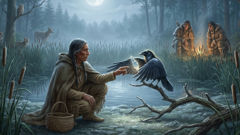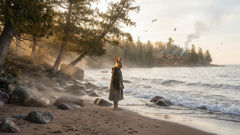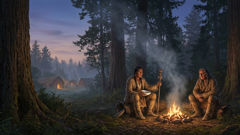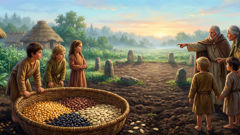Introduction
On the wide shoulders of lakes and the hush of old pine, stories travel like canoe wakes—ripples carrying names through seasons and across generations. Among those names, soft as birch bark and bright as a winter star, is Nanabozho: trickster, teacher, shapeshifter, laughter in the throat of the land. In many tellings across Anishinaabe communities, Nanabozho is both mischief and medicine, one who rearranges the world by accident and intention. This tale traces his footsteps across reed and rock, through winter smoke and summer lightning, honoring the balance he both disturbs and restores. He arrives at a bend in a river disguised as a hare, as a gull, as a greedy man with too many feathers; he departs leaving a lesson braided into the shoreline. What follows is a respectful, imaginative retelling inspired by Ojibwe tradition—meant to share the ethos of listening to animals, knowing the moods of the land, accepting the strange humor of life, and learning that wisdom often comes wrapped in a prank. Pay close attention to the small, ordinary miracles: the way ice cracks like a laughing palm, the way a medicine bundle is shaped by a wrong turn, the way a hungry boy learns to sit with silence and wait. Nanabozho's stories are never tidy; they are pathways. Walk carefully, but walk with curiosity.
The First Mischief: How Nanabozho Shaped River and Rock
Nanabozho's first steps in this telling begin before the dawn that followed the Great Flood. The earth had cooled from a recent conflagration, rivers were new with melted sky, and creatures were learning the contour of their voices. Nanabozho woke with a hunger that was not only for food but for possibility. He stood on a promontory of black rock, listening to the language of the wind, and he decided, as tricksters do, to see what would happen if he tried to name a river differently. He called the water a mirror and a bell and then a drum. The river laughed—bubbled, shifted—and in that laugh it cut a new channel through a patch of loam where the elders had said water would never go. That new bend would later be a place where cranes nested and where children learned to fish with hands cupped like small boats. Nanabozho watched the river rewrite itself like a child tracing new letters in sand.

He was not always kind in his experiments. Once he traded shapes with a mink to slide under a fisherman's net and steal a trout, thinking the theft a clever jest. The fisherman cried, not for fish but for the dignity of the trap that had fed his family, and Nanabozho, realizing he had hurt the line that tied people to their dignity, returned the trout and left a song instead. The song became a song of apology, taught to young ones who were learning to gather by the river. A chorus took the song and turned it into a teaching: that mischief without mending is a hollow thing. In pockets of reeds, old women hummed that tune when they mended nets, smoothing knots as they smoothed the edges of a community's patience.
This pattern—mischief, consequence, mending—repeats like a refrain. In one long evening, Nanabozho decides to stack a line of stones taller than a man and set them trembling only to knock them down with a breath. A boy watching tries to imitate the act and knocks the family cooking stones, scattering them; his grandmother scolds, but then teaches him how each stone served a purpose and how to fit them back so steam rose evenly and the soup did not scorch. The boy learned patience, the boy learned craft, and Nanabozho learned that comedy can be a prompt to craft. He began to understand that a prank might reveal a missing stitch in the fabric of village life, and a stitch could be sewn in more ways than one: with words, with work, with a quiet apology that smelled of cedar smoke.
The animals watched and spoke often. Turtle, slow and sure, said to Nanabozho, "You make our world ripple. Remember that ripples meet shore and change its shape." Bird cawed, "Remember to lift things that weigh too much for one hand." Moose nodded in a way that moved a whole patch of moss. Nanabozho, who loved the sound of his own surprise, often answered with a tilt of his head and a grin that might be deemed inscrutable if the grin were not also warm. Now and then he took a lesson and kept it. He learned, for instance, how to repair a beaver dam by knotting willow in the pattern of a child's woven mat—an act that taught the children how water could be guided rather than feared.
As Nanabozho traveled between lakes and lowlands, his shape changed to suit the day. At dawn he might be a dog, welcome in its hunger and eager loyalty; at noon, a raven, black as the inside of a cooked berry, brilliant in observation; at dusk, an old man whose pockets were full of odd seeds and truths. The world corrected him when he overstepped. Once, hearing of a village where winter stores were thin, he went there disguised as a wealthy trader and offered to trade magic beans for dried meat. The villagers, wise enough in the ways of seasons, saw through the trick. They taught him instead to split a root and cook it so the meat stretched further, and because he had been caught, they taught him the unseen rules of reciprocity. In return, Nanabozho told them a story about the stars, which helped the children identify a pattern in the night sky that would later guide them when the snow erased ordinary landmarks.
There is a tale—told beside long fires—of the night Nanabozho rebuilt a broken canoe. A storm had scattered a family's canoe shards across a low beach, and in his curiosity Nanabozho gathered the pieces and tried to stitch them back with a thread of smoke and a handful of laughter. The canoe floated, but crookedly; it tipped and declared itself insufficient. The family, who understood the language of cedar and sinew, invited Nanabozho to sit while they taught him to shave the planks and bend them with steam. His first attempt splintered when he tried to rush, but he returned the next day with patience polished by the discipline of the elder carpenter. He learned how to listen to the grain of wood and how to ask, rather than command, a material to give its shape. The canoe that finally slid into the water was strong enough to cross a storm because it was built by hands that had argued and then found agreement.
In the quiet pockets between his pranks, Nanabozho set small laws into place that would echo as customs. He planted a willow by a path and told villagers that if a traveler bent it with care and left a prayer woven into the roots, the traveler would find hospitality for as long as the willow lived. The first time someone honored the willow in this way, a stranger arrived with knowledge of a new way to smoke fish that kept wolves away. Soon the willow was a marker of welcome, and what began as a trickster's whim became a sign that bound people to courtesy. The trickster that morning had only wanted a new shade for his hat; the village woke with a new custom.
Nanabozho's laughter is not the kind you only hear in joy; it is a sound that marks turning. It crops up when a child learns to be brave by stepping off a safe stone to reach a prize, when an elder forgives a small theft that hides a larger need, when a storm reworks the shape of a bay and a new harvest appears. He does damage sometimes—he forgets that a tree felled for a joke might be a secret ladder for a nest; he forgets that a mimicry of a parent's voice might startle a child—but the stories that survive are the ones where damage is met with restitution, where a wrong is marched toward repair. The moral is not clean like a polished bead; it is braided like a sash, full of color and inconclusive threads that require attention.
There are nights when Nanabozho disappears entirely from tellings, when silence takes the shape of a winter door and memory seems to sleep. But he always returns by an odd route—carried on the notes of a loon, or by the scratch of a fox's paw along a dwelling's wall—and when he returns, he brings a new shape and a new knot to loosen. He might have become a river rock, and thus know how to keep quiet under pressure; he might have been a bell made of ice, learning the brittle music of cold. His shapeshifting is not merely deceptive; it is a mode of apprenticeship, a way to learn the secret shape of every thing he touches. That knowledge makes him both dangerous and necessary, a figure whose missteps are part of the world's sewing.
When the elders speak of Nanabozho to the young, they do so with a mixture of laughter and warning: listen for his lessons in the middle of his jokes. He teaches humility through embarrassment and skill through confusion. The greatest trick, they say, is often the simplest: to find the courage to face what one has broken and to try, clumsy as one is, to make it whole. That virtue—repair—is one of the earliest and most persistent laws Nanabozho leaves across rock and reed.
By the time the first section of this story closes, a pattern has been set: the trickster as catalyst, the community as mirror, the land as both stage and script. Nanabozho’s first mischiefs ripple into habits, his games into crafts, and what began as personal amusement becomes a grammar for communal life. The river that once curved differently still remembers his laugh in the eddies. The willow still leans where his shadow fell. And the children who learned to be careful and curious carry his echo in the way they take apart and rebuild, perpetually learning the old practice of making things right.
And yet, the tale continues—because Nanabozho is not a single story but a current of stories, flowing and eddying, sometimes placid, sometimes furious. He is the spark behind the first light someone kindled in a cave, the question someone asked at a council that led to a new peace, the grin that comes before a new way of seeing. If you listen, you will hear the small sounds of his passing: a twig snapping in humor, a bell of ice chiming goodbye, the soft tuck of a fox's tail guiding a child home.
So the river keeps going; so do the tales. The next telling will take Nanabozho from craft and custom into the realm of animals who teach and tests that shape the very sky. It will ask what happens when trickery meets hunger, when shapeshifting must answer the questions of survival, and when the laughter has to carry a burden it never expected. There is more mischief to come, and with it, more mending.
Teachings, Trials, and the Ties That Bind
Nanabozho's lessons deepen as seasons turn and as his pranks teach more than laughter. He encounters animals who are not simply actors in his jokes but teachers with their own stern curricula. In one long winter, the geese flew late and a small band of hunters followed their confusion to a frozen inlet where ice lay thin. Nanabozho, disguised as a gentle youth, tempted the hunters with an easier way, an adventurous shortcut across the thin ice. They were nearly lost, but a muskrat's frantic push freed a sliver of open water that calmed the ice just enough to hold the hunters' weight. The hunters learned the truth of the land: impatience can kill, and help can come in the strangest forms. They taught Nanabozho to build snares that catch only what is needed and to leave the rest for the balance of the pond. He learned that scarcity teaches respect for restraint.

At another time, Nanabozho sought out the wisdom of Bear, who was retiring to teach the cubs how to keep sleep when the snow comes. Bear received him at the mouth of a den with slow, deliberate steps and eyes like dark beads. "You are restless," Bear said. "You move like a spring wind and leave frost in your wake. Slow yourself." Nanabozho tried to be still but fidgeted until Bear handed him a stone warmed by the body of the earth and said, "Hold this. Let its weight teach you where to rest." Nanabozho learned how to accept the gravity of responsibilities—how to stay when a village needed him to watch a child's sick night, how to stand guard while the elders spoke in the dark. From Bear he also learned when to harvest honey and when to let it be for the wasps. The trickster's appetite for disruption found a measuring line: the welfare of a community.
The trickster's tests were not only for men. The animals, too, had trials. Raven, forever curious and greedy for shiny things, once stole the moon's reflection from a pond and kept it in his breast feather. The night grew thin and anxious until Nanabozho, with a riddle that smelled of boiled wild rice, challenged Raven to trade. He promised a necklace of sun-bleached beads for the light, and Raven, unable to resist a glittering exchange, agreed and returned the moon's mirror to the water. The pond sang a new song and the night recovered its belly of light. The people, hearing the story, understood how antics between creatures could become promises and how promises could be honored across species. They began to include the riddle in their own winter games, teaching children that sometimes you trade less for more: small goods for a wider peace.
Nanabozho's role in the origin of things magnifies in these years. The story goes that he was responsible for the first corn patch. Hungry and ashamed of his own hunger, he went to a widow's garden where only a few kernels had survived. He promised to double them if she would let him try a strange dance—one foot forward, two steps backward, a hop into the soil—and she, amused, allowed it. The dance disturbed the soil and woke the sleeping magic in the kernels. Next year, the patch produced enough corn not only for the widow but for her whole kin, and the dance became a harvest prayer. Farmers say that when they plant, they remember Nanabozho's clumsy, generous feet and teach their children to respect the seed by singing a small, strange melody while dropping it into the earth.
Yet every lesson he gives drifts into test. In a village overcome by pride—where men boasted of their nets and women spoke louder of their cooking—Nanabozho decided to teach humility. He filled the air with a rumor that a spirit of wind would come and steal the best spoons. People, fearful, hid spoons and accused one another of deceit. The village frayed with suspicion until Nanabozho revealed himself and took the blame, showing the fragility of trust. He proposed a communal forge where spoons would be passed in turns, and the village agreed, learning to temper their pride with mutual stewardship. His trick had planted a trial, and from that trial grew a new custom of rotating tools, which spread as an idea rather than a mandate: the forging of community out of shared need.
Perhaps the most dangerous of his lessons involved a star he once borrowed. The sky had one star whose light was dim and lonely; Nanabozho, feeling mischief and sympathy, plucked that star from its night-shelf and slid it into his pocket. The night grew stranger—animals misread the constellations and walked the wrong migration paths. The elders convened and traced the trouble to a pocket of absent light, and they sent their youngest messenger, a girl who knew the names of every bird, to retrieve the star. She found Nanabozho sitting by a blackened fire with the star in his hands, glowing like a small sun. He had not expected the weight of the sky. Seeing the girl's bravery, he could not help but be moved. He returned the star and, in doing so, learned that taking a thing because one desires it has consequences that echo into the migrations of swans and the timing of berry ripening. The girl, on her return, was celebrated not for conquest but for patience, and the story became a lesson that has guided navigators: to know the sky is to know the seasons.
There are also tender stories—ones that make elders' eyes soften with remembered warmth. Nanabozho once found a child crying at the edge of a forest because she had lost the small carving her grandmother had given her. He pretended to be the wind and promised to search. He came back with a bundle of small things—pine needles, a smooth pebble, a scrap of birch bark—and gave them to the child as a temporary replacement. The child accepted them but still ached for the carved piece. Nanabozho, restless with guilt, returned the carved charm at dawn, having found it beneath a shelf of an old cedar trunk. He did not explain where he had been; he left only the carving and a bracelet of woven sweetgrass as a quiet apology. This act created the custom of leaving a bracelet of fresh sweetgrass as a token of amends—an understated way to say "I mended what I broke." The custom spread because it was small, private, and useful.
By these stories, Nanabozho becomes a teacher who relies on paradox. He must be rebellious to reveal rigidity; he must be foolish to reveal wisdom; he must be shapeshifting to show what is fixed. His teachings are not handed down as rules but enacted as events: a river redirected, a canoe rebuilt, a spoon passed around the hearth. Communities learn by seeing their rules tested and by witnessing the mending that follows. The trickster, in the end, helps people rehearse the future in which they might fail and then, crucially, *repair*.
The ties that bind—between human and animal, family and stranger, season and habit—solidify in the net of these tales. Even when Nanabozho's jokes cause pain, the response tends toward restitution rather than simple punishment. The law of reciprocity becomes the rhythm of daily life. People leave gifts for animals when they take, they call upon the nose of the wind to tell of danger, and they teach children to ask before they take. Nanabozho's role is to prod, not to perfect. He reveals the places where balance has been lost and then offers, often clumsily, a way to restore it.
As his influence spreads, so does a subtle ethic: the world is a conversation. It speaks with a voice that includes the crack of ice, the murmur of a village, the caw of a raven. Nanabozho is the one who reminds all beings to listen in return. His mischief is a call to attention; his mending is a model for repair; his absence is a reminder of how important such a presence is. The elders say his best stories are those that end with people sitting quietly, contemplating their responsibilities as if they were stones to be smoothed and placed with care.
Toward the close of this section, Nanabozho has become both a mirror and a maker. He is the laughter that becomes a song of apology; the theft that becomes a lesson in restraint; the prank that becomes a custom. Children trace his path in the frost with small fingers; hunters whisper his name before tracking; mothers bless their children by invoking the humble mischief that produced the corn patch. The trickster remains restless, but his restlessness has taught a repertoire of responses: listen, mend, share, and laugh with care. The stories continue, because people keep needing to rehearse the arts of living well in a world that insists on change.
There are more tales to tell beyond these temperate lessons—tales of great storms, of the bone-deep winter, of rain that refused to fall until Nanabozho bargained with the clouds. Those narratives carry larger stakes and reach toward the shape of the sky itself. They will be recounted in evenings to come, around fires that remember the texture of his laughter and the way his mistakes knit whole communities into more thoughtful forms. For now, the teaching rests on a simple scaffold: mischief reveals need; restitution builds trust; and culture grows from the practice of repair.
Conclusion
Nanabozho remains, across tellings, a figure who refuses tidy endings. He is trickster and teacher, gambler and guardian, whose laughter is the oldest kind of grammar: a rule that allows exceptions and then demands repair. Where he breaks, communities learn to sew back with care; where he jokes, wisdom often hides like a seed waiting for warmth. These stories are not relics to be preserved in glass; they are living paths people walk when they want to remember how to live with the land and with each other. To honor Nanabozho is to accept complexity—to hold mischief and responsibility together and to teach young ones that the first act of courage is often to admit when you have hurt and then to try to make it right. Let these tales encourage listeners not to imitate the trick without the mending, and to find in the trickster's blunders the invitation to stitch their communities with patience, curiosity, and laughter.













